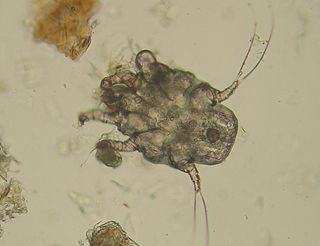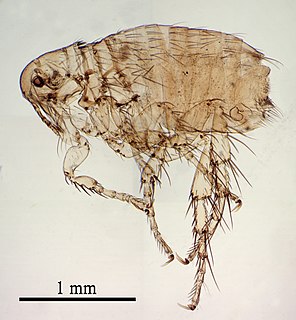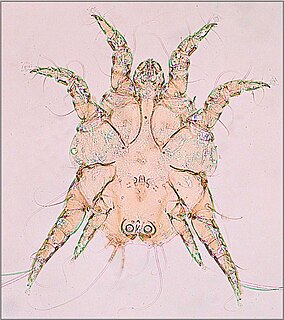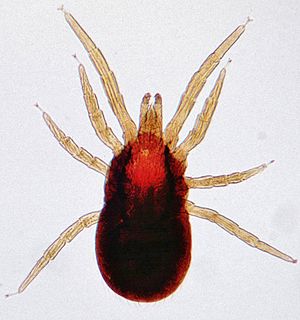
Rabbits are small mammals in the family Leporidae of the order Lagomorpha. Oryctolagus cuniculus includes the European rabbit species and its descendants, the world's 305 breeds of domestic rabbit. Sylvilagus includes 13 wild rabbit species, among them the seven types of cottontail. The European rabbit, which has been introduced on every continent except Antarctica, is familiar throughout the world as a wild prey animal and as a domesticated form of livestock and pet. With its widespread effect on ecologies and cultures, the rabbit is, in many areas of the world, a part of daily life—as food, clothing, a companion, and a source of artistic inspiration.

Parasitism is a symbiotic relationship between species, where one organism, the parasite, lives on or inside another organism, the host, causing it some harm, and is adapted structurally to this way of life. The entomologist E. O. Wilson has characterised parasites as "predators that eat prey in units of less than one". Parasites include single-celled protozoans such as the agents of malaria, sleeping sickness, and amoebic dysentery; animals such as hookworms, lice, mosquitoes, and vampire bats; fungi such as honey fungus and the agents of ringworm; and plants such as mistletoe, dodder, and the broomrapes. There are six major parasitic strategies of exploitation of animal hosts, namely parasitic castration, directly transmitted parasitism, trophically transmitted parasitism, vector-transmitted parasitism, parasitoidism, and micropredation.

Flea, the common name for the order Siphonaptera, includes 2,500 species of small flightless insects that survive as external parasites of mammals and birds. Fleas live by consuming blood, or hematophagy, from their hosts. Adult fleas grow to about 3 millimetres long, are usually brown, and have bodies that are "flattened" sideways or narrow, enabling them to move through their host's fur or feathers. They lack wings, but have strong claws preventing them from being dislodged, mouthparts adapted for piercing skin and sucking blood, and hind legs extremely well adapted for jumping. They are able to leap a distance of some 50 times their body length, a feat second only to jumps made by another group of insects, the superfamily of froghoppers. Flea larvae are worm-like with no limbs; they have chewing mouthparts and feed on organic debris left on their host's skin.

Ticks are parasitic arachnids that are part of the superorder Parasitiformes. Along with mites, they constitute the subclass Acari. Adult ticks are approximately 3 to 5 mm in length depending on age, sex, species, and "fullness". Ticks are external parasites, living by feeding on the blood of mammals, birds, and sometimes reptiles and amphibians. It is estimated ticks originated during the Late Cretaceous period, approximately 120 MYA, the earliest tick fossil in New Jersey amber is dated at 90-94 million years old. Ticks are widely distributed around the world, especially in warm, humid climates.

Myxomatosis is a disease caused by Myxoma virus, a poxvirus in the genus Leporipoxvirus. The natural hosts are tapeti in South and Central America, and brush rabbits in North America. The myxoma virus causes only a mild disease in these species, but causes a severe and usually fatal disease in European rabbits. Myxomatosis is an excellent example of what occurs when a virus jumps from a species adapted to it to a naive host, and has been extensively studied for this reason. The virus was intentionally introduced in Australia, France, and Chile in the 1950s to control wild European rabbit populations.

Cottontail rabbits are among the 20 lagomorph species in the genus Sylvilagus, found in the Americas. Most Sylvilagus species have stub tails with white undersides that show when they retreat, giving them their characteristic name. However, this feature is not present in all cottontails nor is it unique to the genus.

Bartonella is a genus of Gram-negative bacteria. It is the only genus in the family Bartonellaceae. Facultative intracellular parasites, Bartonella species can infect healthy people, but are considered especially important as opportunistic pathogens. Bartonella species are transmitted by vectors such as ticks, fleas, sand flies, and mosquitoes. At least eight Bartonella species or subspecies are known to infect humans.

A domestic or domesticatedrabbit —more commonly known as a pet rabbit, bunny, bun, or bunny rabbit—is a subspecies of European rabbit. A male rabbit is known as a buck, a female is a doe, and a young rabbit is a kit, or kitten. A pet rabbit, belonging to the lagomorphs, is not a pet rodent.

Ear mites are mites that live in the ears of animals and humans. The most commonly seen species in veterinary medicine is Otodectes cynotis. This species, despite its name, is also responsible for 90% of ear mite infections in cats.

The Oriental rat flea, also known as the tropical rat flea, is a parasite of rodents, primarily of the genus Rattus, and is a primary vector for bubonic plague and murine typhus. This occurs when a flea that has fed on an infected rodent bites a human, although this flea can live on any warm blooded mammal.

The cat flea is an extremely common parasitic insect whose principal host is the domestic cat, although a high proportion of the fleas found on dogs also belong to this species. This is despite the widespread existence of a separate and well-established "dog" flea, Ctenocephalides canis.

Myxoma virus is a poxvirus in the genus Leporipoxvirus. There are two broad geographic types of Myxoma virus, Californian and South American. Californian myxoma virus is found on the west coast of the USA, the Baja peninsula of Mexico, and the southwest coast of Canada. South American or Brazilian myxoma virus is found in South and Central America. South American myxoma virus circulates in the jungle rabbit or tapeti, whereas Californian myxoma virus circulates in the brush rabbit. In their native hosts, the viruses cause the formation of benign cutaneous fibromas rather than systemic disease.

Rhipicephalus sanguineus, commonly called the brown dog tick, kennel tick, or pantropical dog tick, is a species of tick found worldwide, but more commonly in warmer climates. This species is unusual among ticks in that its entire lifecycle can be completed indoors. The brown dog tick is easily recognized by its reddish-brown color, elongated body shape, and hexagonal basis capituli. Adults are 2.28 to 3.18 mm in length and 1.11 to 1.68 mm in width. They do not have ornamentation on their backs.

The European rabbit or coney is a species of rabbit native to southwestern Europe and to northwest Africa. It has been widely introduced elsewhere, often with devastating effects on local biodiversity. However, its decline in its native range, has caused the decline of its highly dependent predators, the Iberian lynx and the Spanish imperial eagle. It is known as an invasive species because it has been introduced to countries on all continents with the exception of Antarctica, and has caused many problems within the environment and ecosystems. European rabbits in Australia have had a devastating impact, due in part to the lack of natural predators there.

The dog flea is a species of flea that lives as an ectoparasite on a wide variety of mammals, particularly the domestic dog and cat. It closely resembles the cat flea, Ctenocephalides felis, which can live on a wider range of animals and is generally more prevalent worldwide.
Bartonella alsatica is a proteobacterium. Like other Bartonella species, it can cause disease in animals. It is small, aerobic, oxidase-negative, and Gram-negative. Its rod-like cells were localized within wild rabbit erythrocytes when first described. The type strain is IBS 382T. It is associated with cases of lymphadenitis and endocarditis.

Mites that infest and parasitize domestic animals cause disease and loss of production. Mites are small invertebrates, most of which are free living but some are parasitic. Mites are similar to ticks and both comprise the order Acari in the phylum Arthropoda. Mites are highly varied and their classification is complex; a simple grouping is used in this introductory article. Vernacular terms to describe diseases caused by mites include scab, mange, and scabies. Mites and ticks have substantially different biology from, and are classed separately from, insects. Mites of domestic animals cause important types of skin disease, and some mites infest other organs. Diagnosis of mite infestations can be difficult because of the small size of most mites, but understanding how mites are adapted to feed within the structure of the skin is useful.

Mites are small crawling animals related to ticks and spiders. Most mites are free-living and harmless. Other mites are parasitic, and those that infest livestock animals cause many diseases that are widespread, reduce production and profit for farmers, and are expensive to control.
The hedgehog flea is a flea species which, as indicated by its common name, is an external parasite specifically adapted to living with the European hedgehog and the North African hedgehog, but it has also been found on other animals.
Echidnophaga myrmecobii is a stickfast flea that is native to Australia, and is commonly found on marsupials and rabbits. It is also found on European hares, cats, and dogs.
















